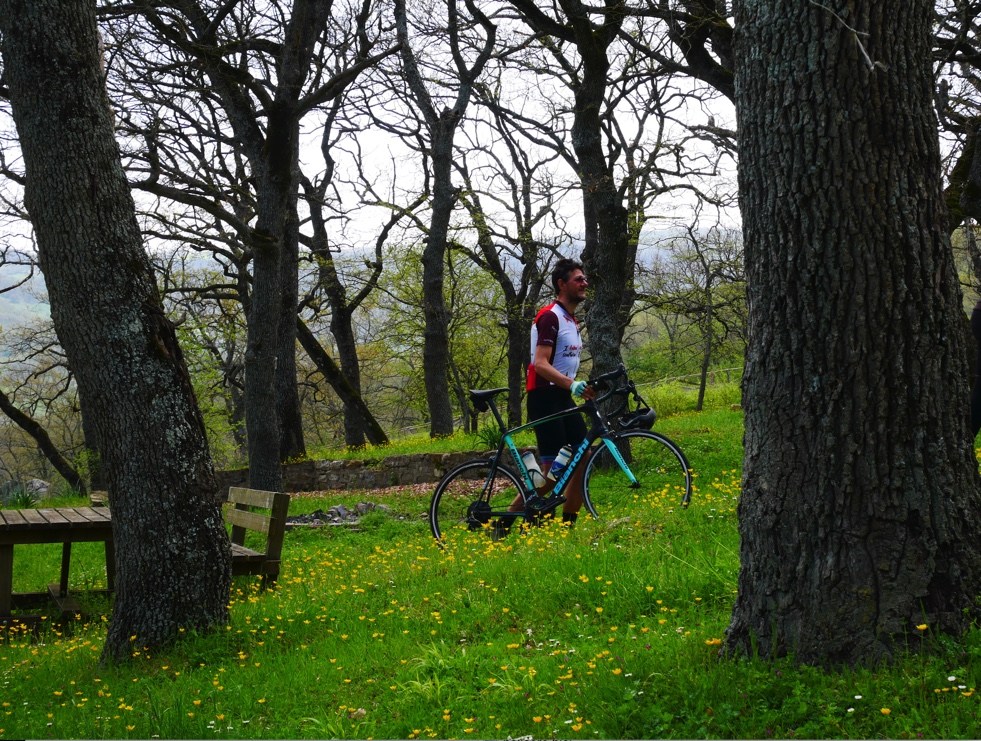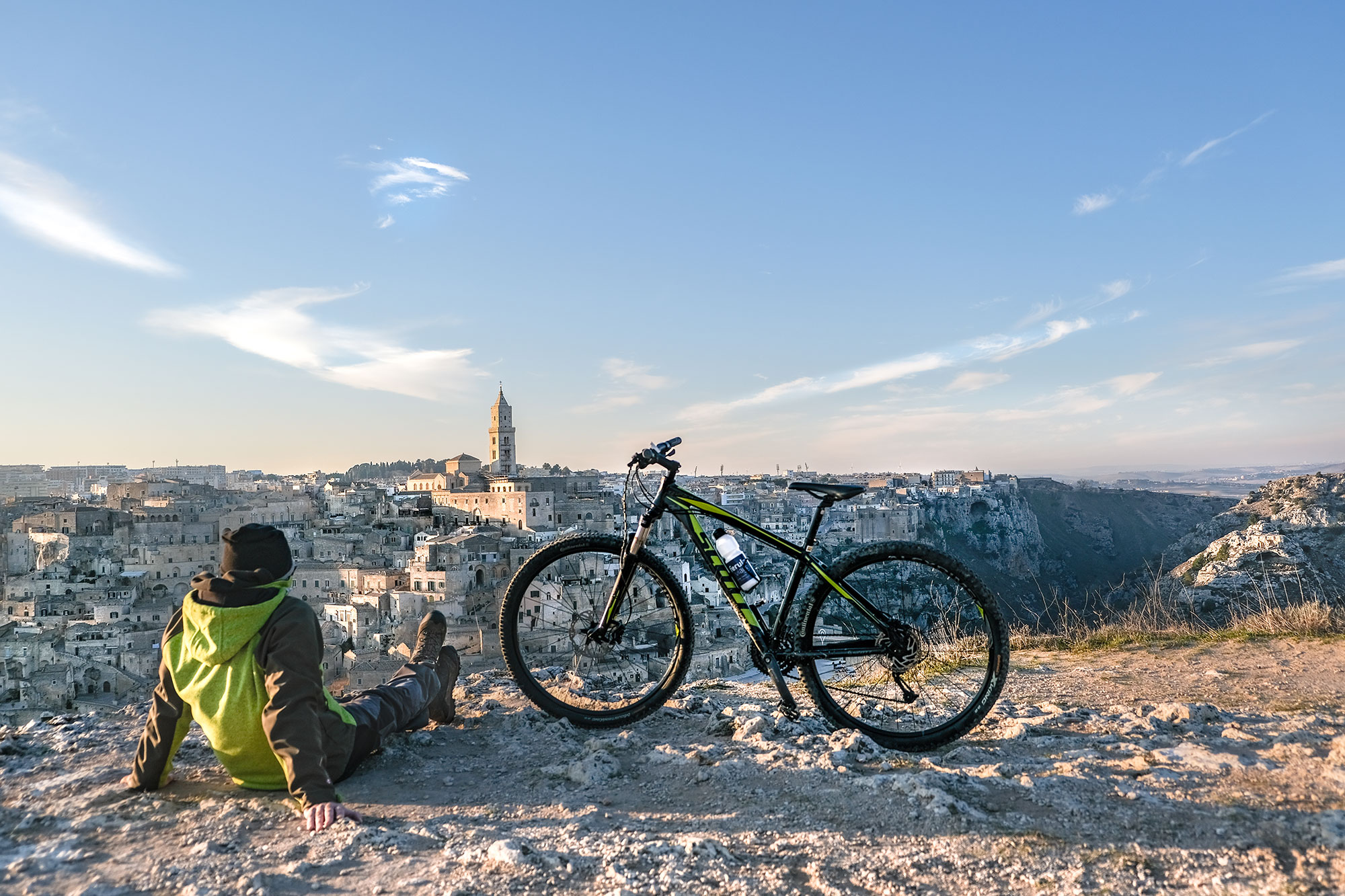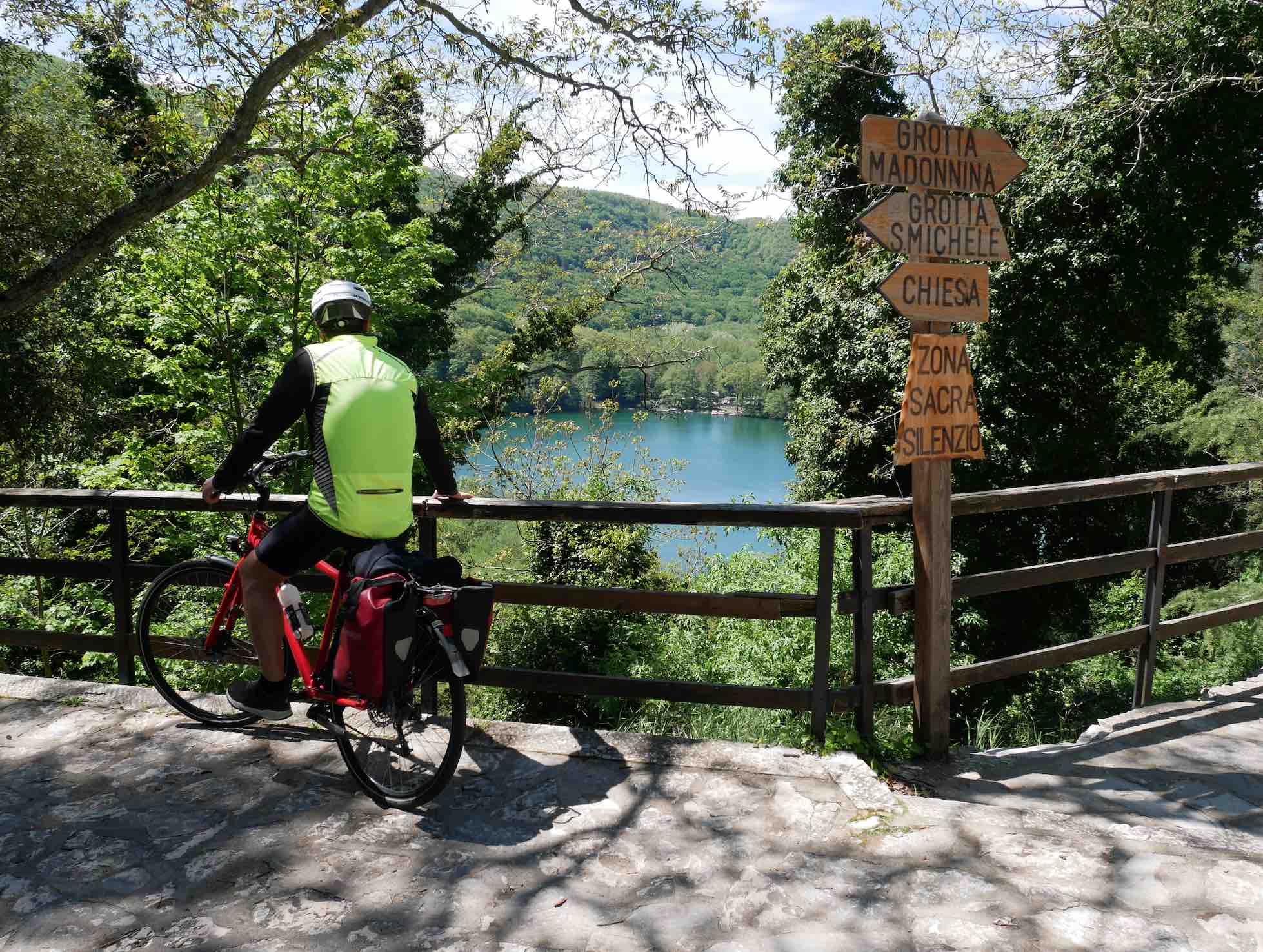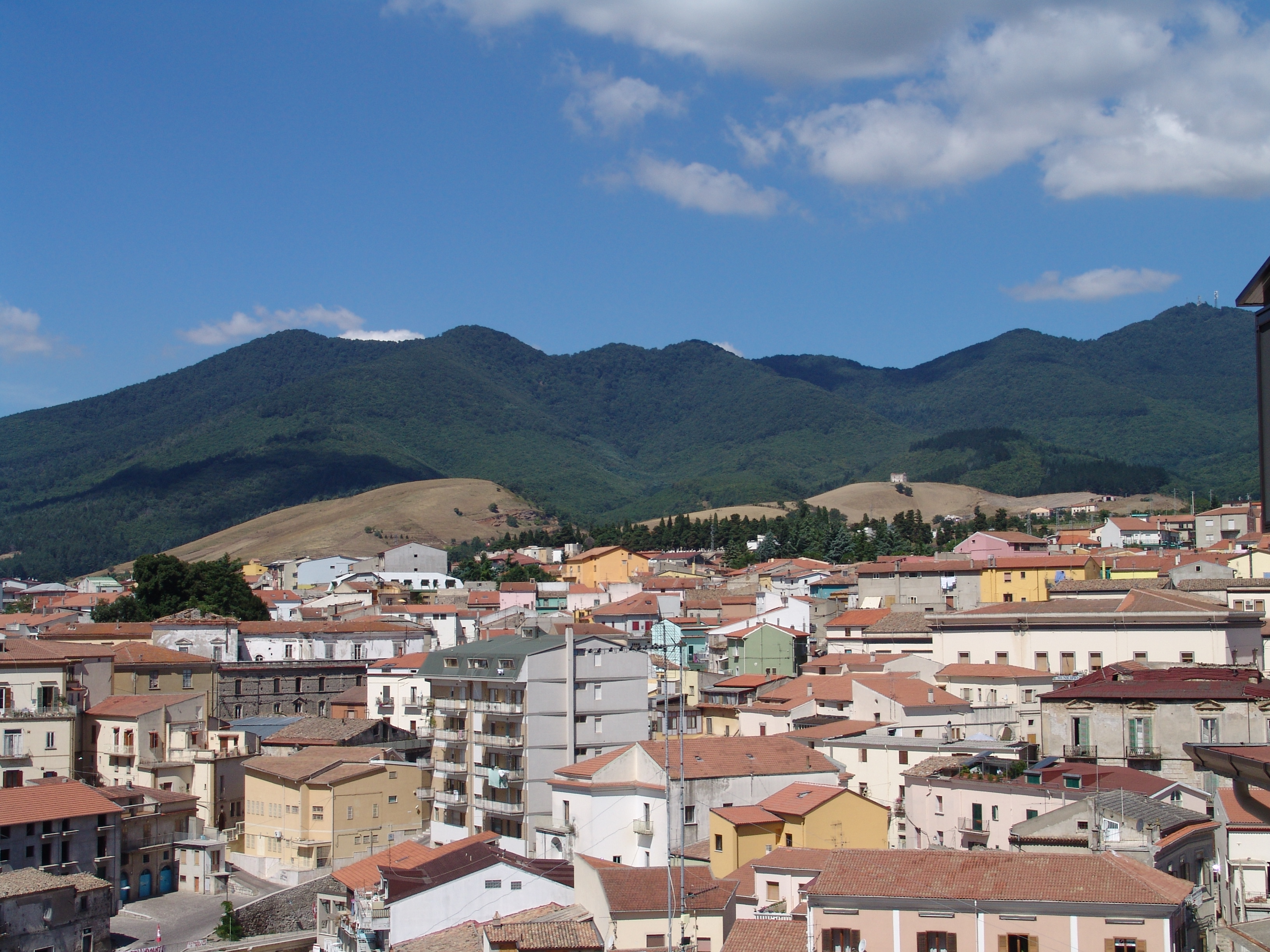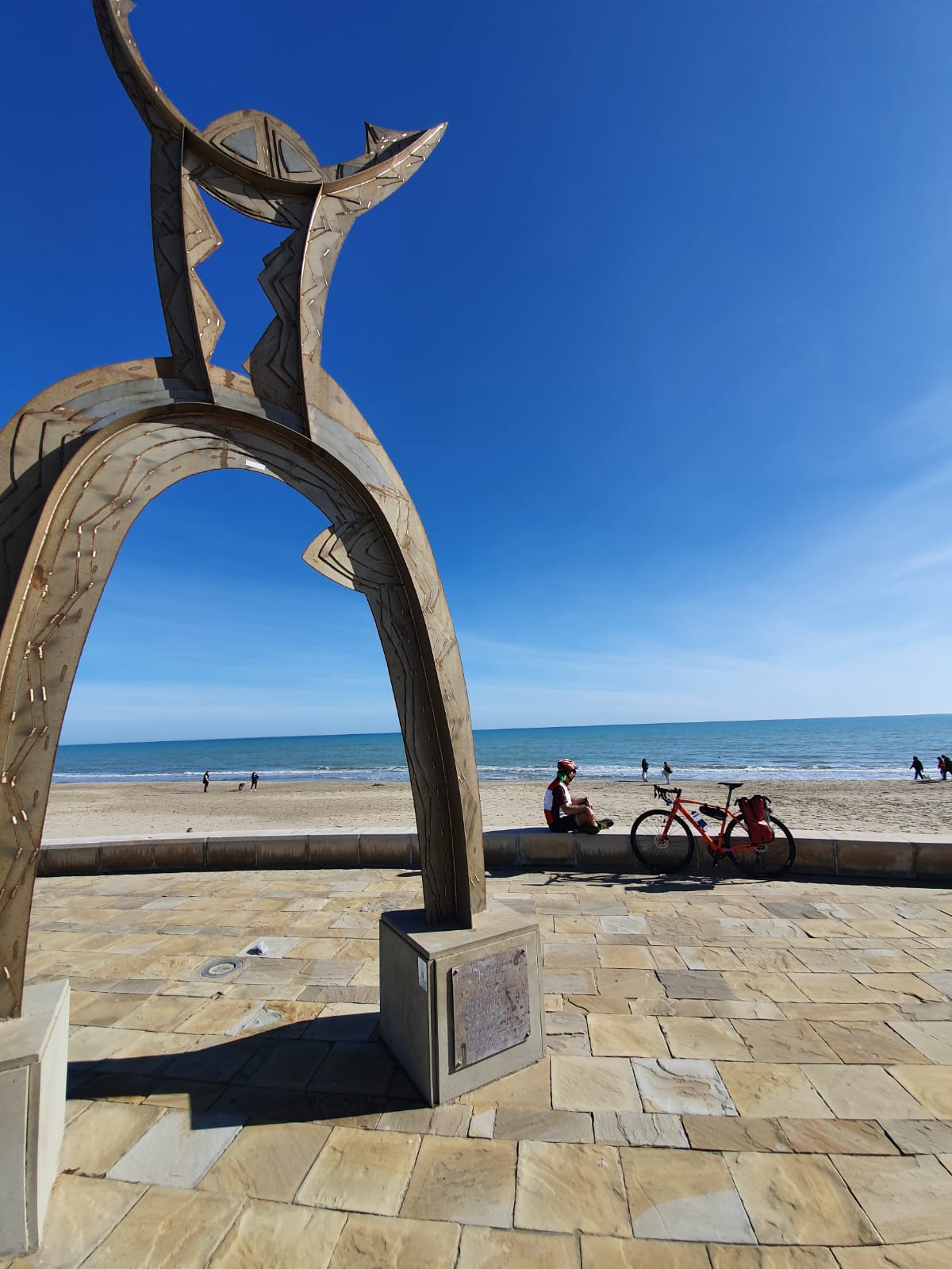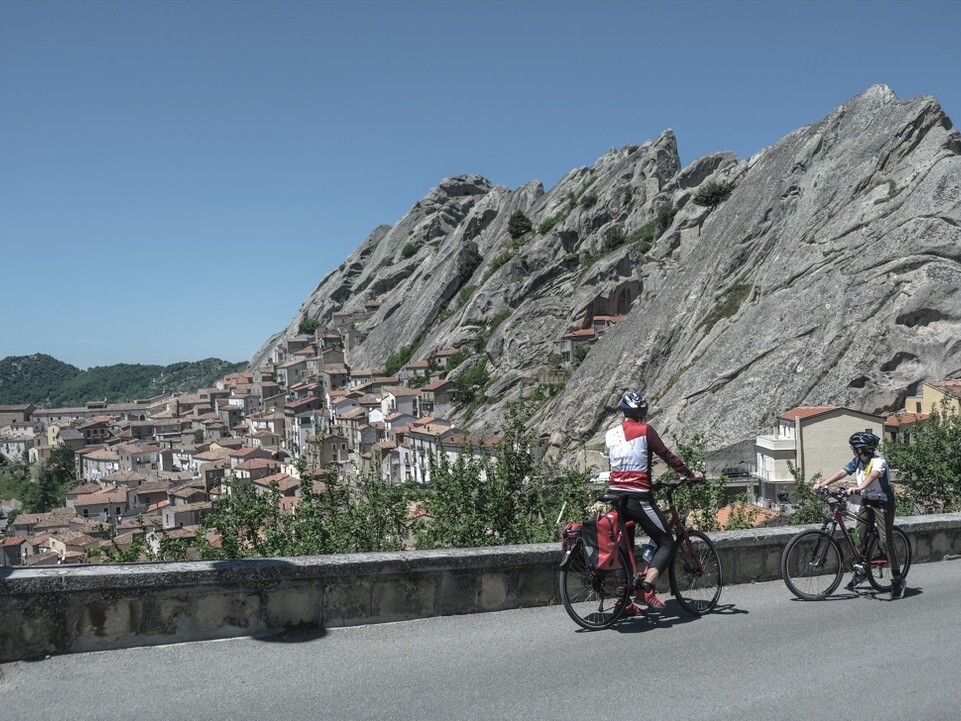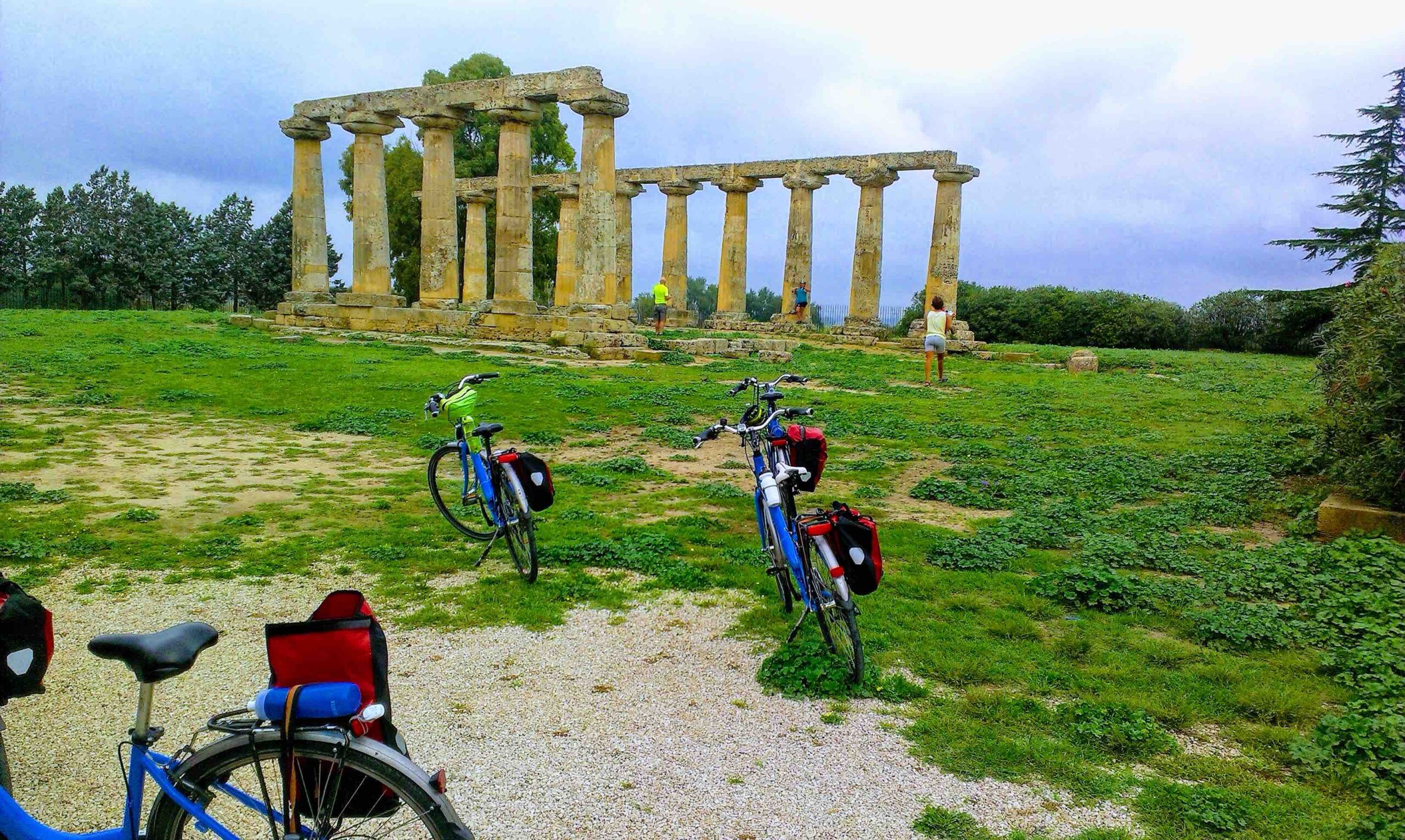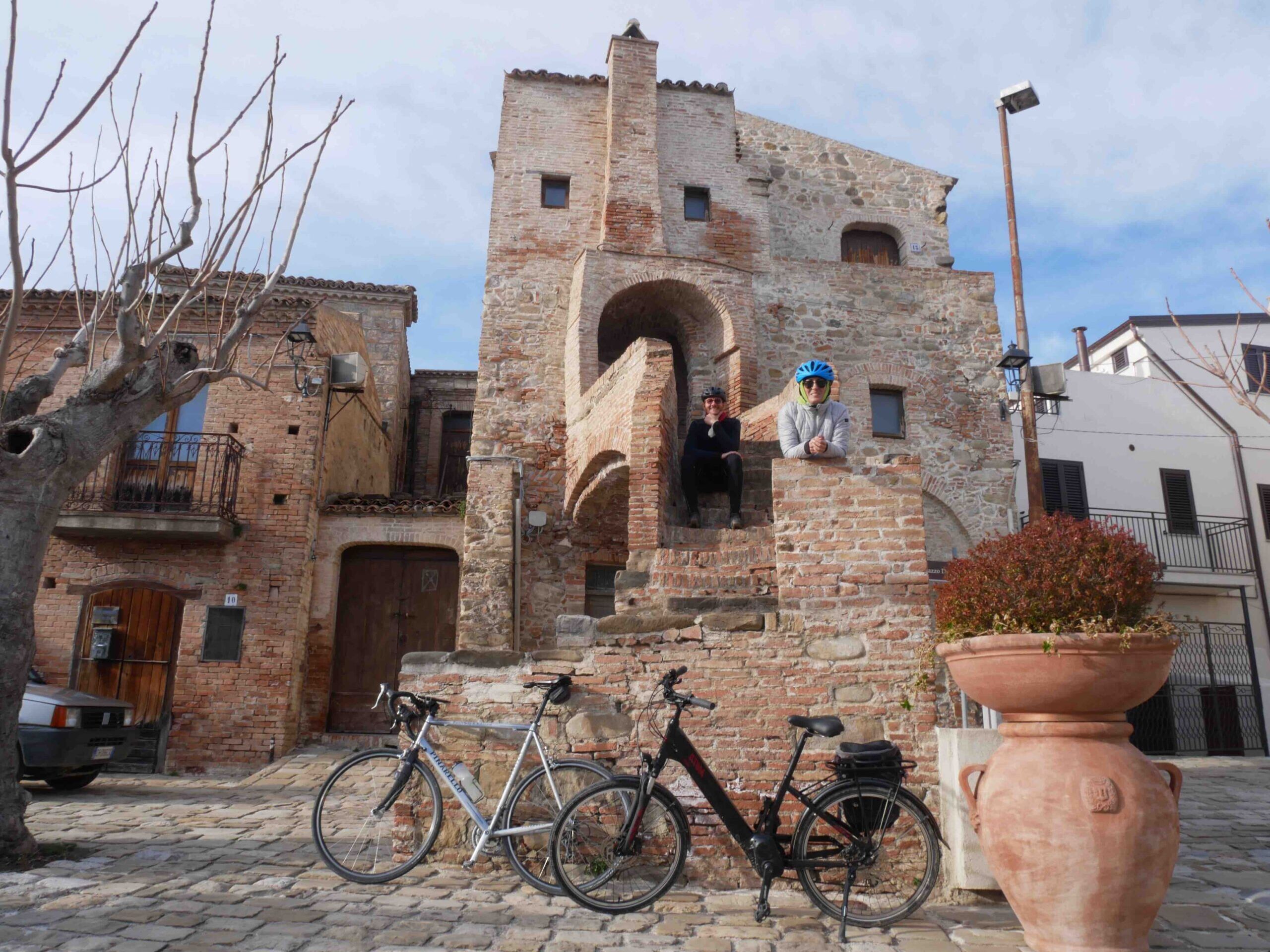11 - Round trip in the mountains of Potenza, climbing up through the greenery to observe the stars
Difficulty: high
Bike type: gravel / road racing / e-bike
Departure: Potenza
Arrival: Potenza
Total miles: 56km
Road surface: 90% asphalt
Height difference ascent: 1710 m
Height difference descent: 1720 m
Time of year: from April to November
Detour to Brindisi di Montagna (+46.4 km round trip)
ROUTE
Circular route with long but cyclable climbs and almost non-existent traffic. Being at a fairly high elevation, the route is not recommended in the middle of winter, but highly recommended in summer, thanks also to the thick tree cover.
ROUTE 11a
It starts from Potenza, the highest regional capital in Italy. Elegant and welcoming, the city develops around the old town centre dating back thousands of years, made up of stately palazzi and ancient gates, medieval towers and historic stone steps, narrow alleys and cobbled streets and featuring the Theatre, museums and art galleries.
The tour continues towards Pantano di Pignola, to admire the Regional Nature Reserve and WWF Oasis of Lago Pantano, another spectacular natural area with signposted trails, rich vegetation and numerous bird species, making it the ideal destination for birdwatching enthusiasts.
After passing Pignola, the town of the “hundred portals” that decorate its beautiful old town centre, you reach the Sellata Pass (1250 masl) in the heart of the Val D’Agri Lagonegrese National Park in the Lucanian Apennines, known for its outstanding natural beauty, and then Monte Pierfaone at and altitude of 1400 metres.
After a spectacular descent to Abriola, the town of San Valentino, patron saint of lovers, made up of a series of narrow streets and unexpected viewpoints, you reach Calvello. Here, the tour allows you to explore other territories, the Lucanian Dolomites, the Pertusillo Dam and the archaeological area of Grumentum.
Strolling through the old centre of Calvello, made up of stone houses stacked together and steep alleys, often reachable only on foot, you discover the small craft shops selling traditional ceramic art.
Leaving Calvello behind you, the route begins to climb again, skirting Anzi, on whose summit stands the Planetario, the Astronomical Observatory that uses a powerful telescope to discover the mysteries of the universe through fascinating journeys among the stars.
The next stop before returning to Potenza is in Rifreddo (1130 masl). Here, you can make a detour to Brindisi di Montagna, a medieval village with panoramic views over the evocative Grancia Forest, which is the stage for the annual performance of ‘La Storia Bandita’.
ROUTE 11b
ROUTE 11 variant
6- Up and down the hills of Matera, a ring route to discover characteristic villages
Difficulty: medium / high
Bike type: touring / road race / e-bike
Departure: Matera – Piazza V. Veneto
Arrival: Matera – Piazza V. Veneto
Total miles: 71 approximately
Road surface: 90% asphalt
Height difference ascent: 1590 m
Height difference descent: 1590 m
Time of year: all year round
ROUTE
Tour of medium-high difficulty which, also considering the length, can be covered in two or more stages.
The route develops on roads with little vehicular traffic except in the vicinity of Matera, where it is necessary to pay attention. The climate and the elevation guarantee it can be traveled all year round, but the best seasons are spring and autumn.
ROUTE 06
The tour takes you along roads with little traffic, except in the vicinity of Matera, where due care must be taken. The climate and the elevation mean the route can be enjoyed all year round, but the best seasons are spring and autumn.
The route begins in Matera, one of the oldest cities in the world and European Capital of Culture 2019. The city is world famous for its Sassi, World Heritage Site since 1993 along with the Park of the Rupestrian Churches.
After leaving the Città dei Sassi, the tour moves on towards Montescaglioso. Once in the town, you can visit the old town centre and the Benedictine Abbey of San Michele Arcangelo.
The next stop is Miglionico. Here, you can climb up to the small old town centre to visit the ancient Castle of Malconsiglio (Bad Council) and the Church of Santa Maria Maggiore, home to the polyptych by Giovanni Battista Cima.
The route continues for nearly 7 miles up and down along a road that offers breathtaking views, first over the Bradano Valley and then the Basento Valley, to reach Grottole. The name recalls the grotticelle, little caves still visible along the slopes of the town and used by craftsmen to mould vases and jugs from clay. Here you can find the fascinating remains of a majestic church dedicated to Saints Luca and Giuliano, left unfinished and called ‘Diruta’.
Cycling enthusiasts who want to pedal on further can extend the tour to reach Grassano, the ‘Nativity Town’. In the stunning Palazzo Materi, you can admire the splendid nativity scene by the local master Franco Artese, thanks to whom, in recent years, the nativity art of Lucania has found its way to the principal squares and churches in Italy and around the world, starting with St Peter’s Square in Rome.
After Grassano, the extended tour takes you to Irsina, one of the oldest towns in Basilicata, famous for the majestic Cathedral of Santa Maria Assunta (13th century), home to a treasure of extraordinary beauty and inestimable value: a sculpture of Santa Eufemia in Nanto stone believed to have been created by Andrea Mantegna.
The non-extended route takes you back to Matera along a spectacular stretch of road with very little traffic, which caresses the hills as it runs alongside the San Giuliano Regional Reserve.
ROUTE 06 variant A
ROUTE 06 variant B
01 – Walking in Vulture-Melfese, a ring-route among ancient castles and fairy-tale woods
Difficulty: medium / high
Bike type: touring / road racing / gravel / e-bike
Departure: Melfi – Train Station
Arrival: Melfi – Train Station
Total miles: 82 approximately
Road surface: asphalt
Height difference ascent: 1390 m
Height difference descent: 1400 m
Time of year: all year round, best in spring / autumn
ROUTE
Itinerario adatto a cicloturisti mediamente allenati, per la presenza di salite importanti e la notevole lunghezza del percorso. Sono segnalate opportune varianti che ne riducono di circa 25-30 km la lunghezza. In alternativa si può effettuare l’intero percorso suddividendolo in tre tappe.
Fruibile tutto l’anno, con la sola eccezione dei giorni in cui il percorso può essere imbiancato, il tour è particolarmente piacevole in primavera e in autunno.
ROUTE 01
A route which is suitable for moderately experienced cyclists due to the presence of significant climbs and the considerable length of the route. A number of possible variants are signposted, which can reduce its length by around 25-30 km. Alternatively, the entire route can be covered in three stages.
While accessible all year round, with the exception of days when the route is covered in snow, this tour is particularly enjoyable in spring and autumn.
The route starts from the Melfi train station and proceeds uphill through wheat fields and centuries-old olive trees. After a few kilometres of ups and downs, the route enters a verdant landscape dominated by the Monticchio Lakes, two expanses of water reflected in the splendid Benedictine Abbey of San Michele, home to the Vulture Natural History Museum.
You set off once more in the direction of Rionero on a tough climb, negotiating hairpin bends flanked by majestic trees. After about 4 km you reach the highest peak of the stage (865 meters above sea level). Just after the top, turn right and head towards Atella / Sant’Andrea di Atella.
Short alternative route
Continuing straight ahead, after about 10 km downhill, you reach Rionero and, crossing the historic centre of the town that was the birthplace of the southern Italian writer Giustino Fortunato, you join the road back to Melfi.
The descent, past farms and wheat fields, leads to Atella, home to marvellous architecture such as the Gate of San Michele and the Cathedral Santa Maria ad Nives. Crossing the valley, you arrive at the Lagopesole Castle, which rises majestically over the entire valley. Built by Frederick II on a pre-existing fort and used by him as a hunting lodge, it now houses a multimedia museum that tells the story of the Swabian emperor.
The itinerary continues towards Rionero and Barile, where a stop in an Aglianico DOC wine cellar is a must. Before returning to Melfi, about 1 km from the centre of Frederick’s town, it is possible to reach and visit the rock church of Santa Margherita.
short alternative route 01
2- Venosa, a ring-route through history, wine and hills
Difficulty: medium / easy
Bike type: touring / road race / e-bike
Departure: Venosa – Pirro del Balzo Castle
Arrival: Venosa – Pirro del Balzo Castle
Total miles: 29 approximately
Road surface: asphalt
Height difference ascent: 880 m
Height difference descent: 987 m
Time of year: all year round, best in spring / autumn
ROUTE
Medium / low difficulty route also suitable for those who do not pedal daily.
The low mileage makes it simple but there are some hill climbs not to be underestimated. The scarce presence of car traffic, except in the vicinity of the larger towns, allows you to cycle in complete tranquility, among the vineyards and cellars of Aglianico DOC, olive groves and mills, interesting archaeological sites and medieval historic centers.
ROUTE 02
In the villages included on this tour, when you sit down to eat, you combine the flavour of unique specialties, seasoned with a drizzle of “Vulture” DOP Extra Virgin Olive Oil (link to Basilicataturistica that we will give you a.s.a.p.), with a delicious, full-bodied, intense and smooth wine: Aglianco del Vulture DOC (link to Basilicataturistica that we will give you a.s.a.p.).
The scarce traffic means you can enjoy a totally peaceful ride, cycling among the vineyards of this fine wine, past olive groves and mills, through archaeological sites and medieval town centres.
The tour sets off in Venosa, the birthplace of the Latin poet Quinto Orazio Flacco. In the heart of this town, officially one of the most beautiful towns in Italy, stands the majestic Pirro del Balzo Castle, home to the National Archaeological Museum and starting point of the tour.
After about 5 miles, you reach Rapolla. This little town is renowned for its fascinating park of wine cellars dug into the volcanic tuff and for its small spa.
At this point of the tour, the more energetic among you can add a visit to Melfi, the city of the majestic Norman-Swabian castle used by Frederick II as a summer residence.
The tour continues towards Barile, one of the Lucanian towns of Albanian origin that still preserves ethnic and linguistic traditions of the Arbëreshë people. The town is famous for the Seshe, caves dug into the tuff and featured in the film by Pier Paolo Pasolini, The Gospel according to St Matthew (1964) and for the Sacred Representation of Holy Week that is staged every year through the local streets.
The next stop is Rionero in Vulture, where you can visit other Aglianico wineries by appointment. A few miles from Rionero, you reach the Monticchio Lakes, which fill the crater mouths of the ancient volcano on the south-western slope of Monte Vulture.
From here, it is just a few miles to Ripacandida. The small town is also described as the “little Assisi” of Basilicata for the fine Giotto frescoes that decorate the walls of the splendid sanctuary dedicated to San Donato Vescovo, patron saint of the town.
The last stretch, before returning to Venosa, crosses through Ginestra, another Arbëreshë town in Basilicata.
ROUTE 02b
ROUTE 02 variant
04- Cycling through history, from Matera to Magna Graecia
Difficulty: easy
Bike type: gravel / touring / e-bike/
Departure: Matera – Piazza V. Veneto
Arrival: Metaponto Lido
Total miles: 57.2 km
Road surface: 95% asphalt
Height difference ascent: 160 m
Height difference descent: 550 m
Time of year: all year round
ROUTE
This route is also suitable for less experienced cyclists and can be covered in a single day.
ROUTE 04
The city is world famous for its Sassi, Matera, a World Heritage since 1993 along with the Park of the Rupestrian Churches.
After a long, pleasant descent, which runs along the Gravina river and the Park of the Rupestrian Churches, you reach the vicinity of Montescaglioso.
During the journey, with the aid of an expert guide, it is possible to stop at the Parco dei Monaci and the new Visitor Center of the Murgia di Pianelle Park and from there follow some paths to explore churches, ravines and evidence of ancient presences (Madonna della Loe, Murgia Sant’Andrea).
At 13 km from the start, take the “Messapica” road in the direction of Miglionico.
Variation: continue straight ahead to Montescaglioso and visit the ancient Benedictine Abbey of San Michele Arcangelo (1079), the most notable of the four monastic complexes that have earned Montescaglioso the nickname of “City of Monasteries”.
To return to the proposed route, leave Montescaglioso and follow signs for Metaponto until, after a steep descent, you reach a junction at the border with the province of Taranto.
There is a steep descent and then a road that winds gently through the hills until it reaches the Jonica state road. A few kilometres along the slip road and you find yourself in the Magna Graecia, in the shadow of the Palatine Tables, the remains of a Greek temple dedicated to Hera. The journey through history continues with a visit to the Archaeological Museum, the custodian of a past in which Metapontum was the ‘capital’ of Magna Graecia. After this wonderful ride, caressed by the sea breeze, you can take a barefoot walk on the sandy beaches of the Ionian coast.
ROUTE 04 variant
7- From Matera to the Piccole Dolomiti Lucane for a breathtaking ride
Difficulty: high
Bike type: gravel / touring / e-bike
Departure: Matera – Piazza V. Veneto
Arrival: Pietrapertosa
Total miles: 71 approximately
Road surface: 90% asphalt
Height difference ascent: 2040 m
Height difference descent: 1440 m
Time of year: from March to October
ROUTE
The tour combines two important protected areas of the region: the Park of the Rupestrian Churches and the Murgia Materana and the Park of Gallipoli Cognato and the Piccole Dolomiti Lucane (in addition to the San Giuliano Regional Reserve).
ROUTE 07
The route begins in Matera, one of the oldest cities in the world and European Capital of Culture 2019. The city is world famous for its Sassi, World Heritage Site since 1993 along with the Park of the Rupestrian Churches.
After leaving the Città dei Sassi, the tour moves on towards Grassano, skirting Lake San Giuliano. The small town of Collina Materana is known as the Città del Presepe (Nativity Town). In the stunning Palazzo Materi, you can admire the splendid nativity scene by the local master Franco Artese, thanks to whom, in recent years, the nativity art of Lucania has found its way to the principal squares and churches in Italy and around the world, starting with St Peter’s Square in Rome.
The tour then heads towards Accettura, one of the little towns in the Park of Gallipoli Cognato and the Piccole Dolomiti Lucane. In the heart of the countryside, its name is connected above all to Il Maggio di Accettura, an ancient and characteristic arboreal rite that is repeated every year in Basilicata, linked to the fertility of the earth and the renewal of life.
After crossing the Montepiano Pass, you reach Pietrapertosa. Officially recognized as one of the most beautiful towns in Italy, it owes its fame to the Volo dell’Angelo (Flight of the Angel): an adrenaline-fuelled flight hanging belly down from a steel cable, travelling at speeds of up to 120 km/h, to reach Castelmezzano, a mile away, in just over a minute.
The tour can be extended from here precisely to visit Castelmezzano, also counted among the most beautiful towns in Italy and, like Pietrapertosa, a destination for the more adventurous tourists who wish to experience the thrill of flight, alone or in pairs.
High difficulty route suitable for bicycle touring experts that can also be completed in two or three stages, thus making it less tiring.
ROUTE 07 variant A extension
ROUTE 07 variant B Cripta del Peccato Originario
05 - From Magna Graecia to the lunar landscapes of the Calanchi
Difficulty: moderate
Bike type: gravel / road racing / e-bike
Departure: Metaponto Lido
Arrival: Tursi – Rabatana
Total miles: 80 approximately
Road surface: asphalt
Height difference ascent: 890 m
Height difference descent: 610 m
Time of year: all year round
ROUTE
From the golden beaches of the Ionian coast of Lucania to the discovery of Magna Graecia crossing orchards and vineyards to reach lunar landscapes and Saracen villages.
ROUTE 05
It starts from the seafront of Metaponto and offers an unforgettable journey through history. Completely immersed in Magna Graecia, the tour passes by the Palatine Tables, the remains of a Greek temple dedicated to Hera.
After a short stretch on the highway, you go back to cycling through nature to reach Bernalda, the town of origin of the paternal grandparents of the Italian-American director Francis Ford Coppola, who often returns here.
Passing through orchards and vineyards, with the possibility of visiting some wine cellars and tasting the excellent local wine, we reach Montalbano Jonico, the land of the badlands. Here you can take in a lunar landscape where weather conditions and the crumbling of the clayey soil have created authentic natural sculptures of spires, pinnacles and deep canyons.
Cycling through the orange groves, about 20 kilometres from the coast, you reach Tursi. The village, which features the Rabatana district founded by the Saracens, is known for the Sanctuary of Santa Maria di Anglona, built where the Greek city of Pandosia once stood.
It is not to be missed.
From here, a provincial road leads directly to Policoro, the ancient Heraclea. The sea and the archaeology, the unspoilt nature of the Bosco Pantano reserve, the fragrance of the famous strawberries and other local produce are all part of the journey through the very varied territory of Policoro and Magna Graecia.
The route, of moderate difficulty, can be divided into 2 stages.
03 - From Horace's town to the Palmenti, among the wheat fields of the Bradano Valley
Difficulty: high
Bike type: touring / road race / e-bike
Departure: Venosa
Arrival: Pietragalla
Total miles: 41 approximately
Road surface: asphalt
Height difference ascent: 1200 m
Height difference descent: 800 m
Time of year: recommended from March to November
ROUTE
From Vulture to the Bradano valley, a highly difficult itinerary in the northern area of the region.
ROUTE 03
We set off from Venosa, officially designated as one of the most beautiful towns in Italy, home to the Latin poet Quintus Horatius Flaccus and the Renaissance madrigalist Gesualdo da Venosa. In the heart of this village stands the majestic Pirro del Balzo castle, home to the National Archaeological Museum, while in the immediate vicinity stands the Holy Trinity Complex and the majestic Incompiuta.
The next stop is Palazzo San Gervasio. This village, built around the castle commissioned by Frederick II, is known for its Art Gallery, which houses masterpieces of 17th and 18th-century Neapolitan painting along with ancient texts that Camillo d’Errico, a refined Lucanian patron and passionate collector, donated to the village.
Skirting Lake Fontetusio, the itinerary continues in the direction of Banzi, where you can admire the remains of the oldest Benedictine abbey in Basilicata (9th century), near to which was found the ‘Tabula Bantina’ , an epigraphic text on a bronze slab written in Oscan with Latin characters, now preserved in the National Archaeological Museum in Naples.
After a few miles, you reach Genzano di Lucania, where you can admire the Fontana Cavallina, one of the 33 most beautiful fountains in Italy, and the old town centre recently decorated with some splendid murals created by an unknown Lucanian Banksy.
From here, the route becomes more demanding, climbing to Oppido Lucano, home to a veritable treasure of rock art: a series of Renaissance frescoes, inspired by the apocryphal gospels, which decorate the splendid rupestrian church of Sant’Antuono.
Variation: From Oppido, just a few miles on, turn right to visit Acerenza, the Cathedral City, so called because it is overlooked by the bishop’s see, which was commissioned by the Norman leader Robert Guiscard.
The tour ends in Pietragalla, a town best known for its Palmenti, wine cellars dug into the rock and still used today for pressing and storing wine.
Fairly difficult route that is best completed in two stages.
ROUTE 03b
ROUTE 03c
ROUTE 03d variant
10 - Following the soft geometries of the Lucanian badlands
Difficulty: medium / high
Bike type: touring / road racing / gravel / e-bike
Departure: Salnadra
Arrival: Aliano
Total miles: 95 approximately
Road surface: asphalt
Height difference ascent: 1460 m
Height difference descent: 1460 m
Time of year: from March to November, pleasant in spring and autumn
ROUTE
The tour of the land described by Carlo Levi in his “Cristo si è fermato a Eboli” (Christ Stopped at Eboli), which we recommend is taken in stages due to its length and degree of difficulty,
ROUTE 10
Begins in Salandra, a village founded in Norman times, situated on a rock and surrounded by clay ravines, woods and areas of great archaeological interest.
After 20 km the route takes us to Ferrandina. Founded in 1490 by Frederick and Isabella of Aragon, the village is famous for being a Slow Food Presidium of Majatica, a quality of olive tree found only in some areas of the Matera hills from which the famous Black Baked Ferrandina Olive and Extra Virgin Olive Oil are made.
Descending the slope you reach a flat area, where the cultivated fields become orchards, in a succession that leaves more and more room for the “lunar” landscape of the ravines. Eventually, you reach Craco Vecchia, the village that was completely abandoned in the 1960s following a landslide and is now a destination for internationally renowned photographers and directors.
After a few kilometres on the flat and a steep final climb, you reach Aliano. Perched on a clay ridge, Aliano is the town of the Calanchi (badlands) and Carlo Levi’s exile, surrounded by the evocative and lunar landscape that the painter and doctor from Turin described in his novel Cristo si è fermato a Eboli (Christ Stopped at Eboli).
09 - From the green woods of the Gallipoli Cognato Regional Park to the golden expanses of the Ionian Coast
Difficulty: medium / high
Bike type: touring / road racing / gravel / e-bike
Departure: Accettura
Arrival: Policoro
Total miles: 65 approximately
Road surface: asphalt
Height difference ascent: 1230 m
Height difference descent: 1990 m
Time of year: from April to November
ROUTE
Long and spectacular route along the ridge that stretches from the heart of the region to the Ionian coast.
ROUTE 09
Accettura, the starting town, is found in the Regional Park of Gallipoli Cognato and Piccole Dolomiti Lucane. In the heart of the countryside, its name is connected above all to Il Maggio di Accettura, one of the most ancient arboreal rites in Basilicata, linked to the fertility of the earth.
Crossing the forest of Gallipoli Cognato, the tour makes a stop in San Mauro Forte, the town of the “Cowbells” that ring loudly to herald one of the most important Carnivals in Basilicata.
Enjoying the natural spectacle provided by the calanchi (badlands), you reach Craco, the “ghost town”, destroyed in 1963 by a landslide that forced the local population to abandon it and take refuge in the new town of Craco Peschiera.
The tour continues towards Tursi and the ancient quarter of Rabatana – the name taken from rabat or fortified town – and, in fact the district is very hard to access, like all quarters of Arab origin.
After a visit to the Sanctuary of Santa Maria di Anglona, proclaimed a national monument in 1931, we move on to the Ionian coast, to Policoro, site of the ancient Heraclea. The sea and archaeology, the unspoiled nature of Bosco Pantano, the scent of the famous strawberries and other fruits of the earth, on a journey into the very varied territory of Policoro and Magna Graecia.


